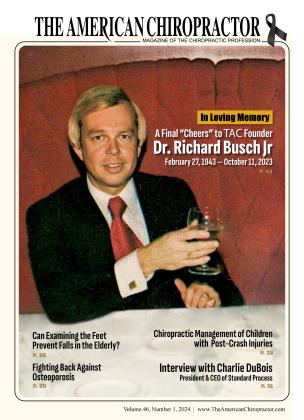The Most Important Factors Revealed
January 1 2024 Gregory M. KingsburyThe Most Important Factors Revealed
January 1 2024 Gregory M. KingsburySelling or Buying a Chiropractic Practice
ENTERPRENEURSHIP
The Most Important Factors Revealed
Gregory M. Kingsbury DC
WAS THE FIRST BROKER IN THE COUNTRY who focused exclusively on helping DCs sell or buy a chiropractic practice. My 37 years of working with clients in virtually every state has given me a unique perspective.
Many DCs have hired accountants, former business appraisers, and financial consultants to assist them in the sale or purchase of a practice. However, being a DC who has owned, managed, and clinically worked with patients provided me with a distinct advantage.
Knowing the gross and net receipts of a particular practice and having familiarity with various techniques, diagnostic protocols, business management, and how insurance reimbursement works is an important part of the equation. However, it does not tell the whole story of a practice’s fair market value or selling price.
Analytics of a Practice
We have performed an analysis of over 300 practices from various regions of the United States, compiled the results, and determined some very pertinent statistics.
Optimal Practice Statistics Evaluation
A. New patients (per month)
1. 0 to 10 = Poor practice, no growth.
2. 11 to 20 = Slightly below average, slow growth.
3. 21 to 30 «= Average, consistent, slow growth when combined with proper management procedures.
4. 31 to 40 = Good, rapid, and steady growth.
5. 41+ = Superior, only 1% of all practices are in this category.
B. Office visits (per week)
1. Under 100 = Poor, no growth.
2. 100 to 130 = Average, equal to national norm for chiropractic practices.
3. 130 to 175 = Good, above national norm.
4. 175 to 200 = Excellent, practice growth and patient retention above national norm.
5. 250+ = Superior, top 1% of all practices.
C. Patient visit average (retention rate)
1. 1 to 16 = Pain relief only practice. No corrective or maintenance care.
2. 17 to 25 = Pain relief with some corrective care visits. Slow growth.
3.26 to 35 = Solid, average practice with slow, consistent growth.
4. 36 to 45 = Fast growth with good balance of pain relief and corrective protocols.
5. 45+ = Superior. Top 1%. Large percentage of patient compliance with recommendations for pain relief, corrective, and maintenance care.
D.Case average
1. $45.00 to $550.00 = Acute care only.
2. $551.00 to $1,000.00 = Acute care with minimal corrective.
3. $1,001.00 to $1,500.00 = 75% of patients follow through with program of acute and corrective care.
4. $1,501.00 to $2,000.00 = Patient follow-through with 80% to 90% of doctor recommendations for pain relief, corrective, and maintenance care.
5. $2,001.00 and above = Superior. Majority of patients understand the value of and comply with the complete recommended schedule of chiropractic care. This includes total follow-through with acute/pain relief, corrective, and ongoing maintenance care.
Fair Market Value Based on StatisticalAnalysis and Nationwide Chiropractic Practice Comparables
1. Case average: The dollar amount the practice collects on average for each patient treated, including pain relief, corrective, and maintenance care.
2. Patient visit average: The average number of visits for each patient treated.
3. Office visit average: Defined as the average fee collected per visit from each patient.
4. New patient average: The average number of new patients seen on a monthly basis.
5. Collection ratio: The percentage amount of all billings collected for chiropractic services.
These averages can vary from area to area due to variances in a chiropractor’s fee structures in different regions of the country. They were determined by a review and compilation of the various statistical categories taken and analysis of 300 different practices.
A high-quality practice procedurally, managerially, financially, and clinically is one that will sell much faster by attracting buyers who understand the individual statistics and how they figure into the gross and net receipts.
The bottom line is that just analyzing tax forms, profit-and-loss statements, and practice finances does not provide enough information to determine fair market value and will not help make a practice more saleable or a buyer more likely to purchase.
Dr. Greg Kingsbury is a licensed Doctor of Chiropractic, President of ChiroEquity a practice brokerage assisting sellers and buyers of chiropractic practices for over 37 years. Graduated from Palmer College of Chiropractic in 1975. Currently lives and operates his business from New Providence NJ. You can reach out to Dr. Greg at [email protected], or at 908-419-7510.
 View Full Issue
View Full Issue









